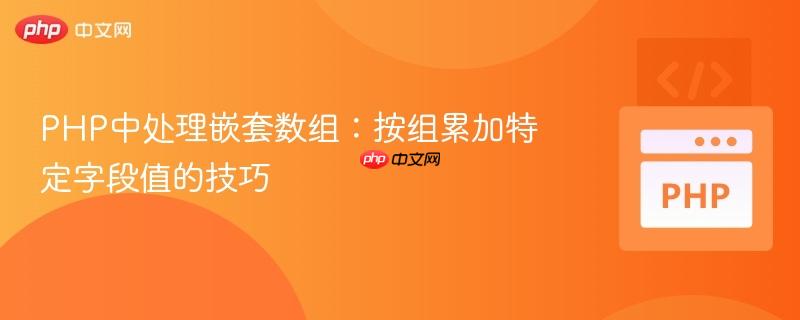
本教程将详细讲解如何在php中处理多维嵌套数组,特别是当需要根据外部数组键对内部元素的特定字段(如数量)进行分组累加时。我们将通过嵌套foreach循环和巧妙的计数器管理,实现按组统计的功能,并提供清晰的代码示例,同时探讨laravel collection的更优雅解决方案。
在数据处理中,我们经常会遇到需要对复杂结构的数据进行统计分析的场景。一个常见需求是,给定一个按特定键(例如供应商ID)分组的多维数组,我们需要计算每个组内某个特定字段(例如产品数量)的总和。本文将深入探讨如何高效地实现这一目标,并提供两种主要的解决方案:基于原生PHP的嵌套循环方法和基于Laravel Collection的链式操作方法。
假设我们有一个多维数组,它代表了按供应商分组的产品订单信息。数组的顶层键是供应商ID,每个供应商ID对应一个包含多个产品详情的子数组。每个产品详情又是一个关联数组,其中包含supplier_id、child_product_id、quantity和shipping_cost等字段。
以下是示例数据结构:
$groupedProducts = [
1 => [ // 供应商ID 1
[
"supplier_id" => 1,
"child_product_id" => 54634,
"quantity" => 2,
"shipping_cost" => "4.99"
],
[
"supplier_id" => 1,
"child_product_id" => 24723,
"quantity" => 1,
"shipping_cost" => "4.99"
]
],
2 => [ // 供应商ID 2
[
"supplier_id" => 2,
"child_product_id" => 19533,
"quantity" => 1,
"shipping_cost" => "18.00"
]
]
];我们的目标是计算每个供应商(即每个顶层键)下的所有产品quantity字段的总和。例如,对于供应商ID为1的组,总数量应为 2 + 1 = 3;对于供应商ID为2的组,总数量应为 1。简单地对整个数组进行扁平化求和是不可取的,因为它会得到所有供应商的总数量,而不是按供应商分组的总数量。
立即学习“PHP免费学习笔记(深入)”;
对于任何PHP项目,无论是否使用框架,都可以通过标准的foreach循环来解决这个问题。核心思想是使用两层循环:外层循环遍历供应商组,内层循环遍历每个供应商组内的产品。
<?php
$groupedProducts = [
1 => [
['supplier_id' => 1, 'child_product_id' => 54634, 'quantity' => 2, 'shipping_cost' => "4.99"],
['supplier_id' => 1, 'child_product_id' => 24723, 'quantity' => 1, 'shipping_cost' => "4.99"],
],
2 => [
['supplier_id' => 2, 'child_product_id' => 19533, 'quantity' => 1, 'shipping_cost' => "18.00"],
]
];
$supplierQuantities = []; // 用于存储最终结果的数组
foreach ($groupedProducts as $supplierId => $products) {
$currentSupplierTotalQuantity = 0; // 为每个供应商重置计数器
foreach ($products as $product) {
$currentSupplierTotalQuantity += $product['quantity']; // 累加当前产品的数量
}
// 将当前供应商的总数量存储到结果数组中,键为供应商ID
$supplierQuantities[$supplierId] = $currentSupplierTotalQuantity;
}
echo "按供应商分组的总数量:\n";
print_r($supplierQuantities);
/*
输出结果:
按供应商分组的总数量:
Array
(
[1] => 3
[2] => 1
)
*/对于使用Laravel框架的开发者来说,Laravel Collection 提供了一种更优雅、更具表达力的方式来处理数组数据。通过链式调用方法,我们可以实现与上述原生PHP方法相同的功能,但代码通常更简洁、可读性更强。
要使用Collection,首先需要将原始数组转换为Collection实例。然后,我们可以利用groupBy()方法按特定键进行分组,再结合map()或sum()方法对每个分组进行聚合操作。
假设我们有一个扁平化的产品列表,其中每个产品都包含supplier_id字段,我们需要先按supplier_id分组。
<?php
use Illuminate\Support\Collection; // 确保引入 Collection 类
// 假设这是从数据库查询或某个地方获取的扁平化产品列表
$allProducts = collect([
['supplier_id' => 1, 'child_product_id' => 54634, 'quantity' => 2, 'shipping_cost' => "4.99"],
['supplier_id' => 1, 'child_product_id' => 24723, 'quantity' => 1, 'shipping_cost' => "4.99"],
['supplier_id' => 2, 'child_product_id' => 19533, 'quantity' => 1, 'shipping_cost' => "18.00"],
]);
// 1. 使用 groupBy('supplier_id') 按供应商ID分组
// 2. 使用 map() 遍历每个供应商组
// 3. 在 map 的回调函数中,对当前供应商组的产品使用 sum('quantity') 求和
$supplierQuantitiesCollection = $allProducts->groupBy('supplier_id')
->map(function (Collection $productsPerSupplier) {
return $productsPerSupplier->sum('quantity');
});
echo "使用 Laravel Collection 按供应商分组的总数量:\n";
print_r($supplierQuantitiesCollection->toArray());
/*
输出结果:
使用 Laravel Collection 按供应商分组的总数量:
Array
(
[1] => 3
[2] => 1
)
*/如果你的初始数据已经是按供应商ID分组的Collection(例如,$groupedProducts 变量已经是一个Collection),你可以直接对其进行map操作:
<?php
use Illuminate\Support\Collection;
$groupedProductsCollection = collect([
1 => collect([ // 供应商ID 1
['supplier_id' => 1, 'child_product_id' => 54634, 'quantity' => 2, 'shipping_cost' => "4.99"],
['supplier_id' => 1, 'child_product_id' => 24723, 'quantity' => 1, 'shipping_cost' => "4.99"],
]),
2 => collect([ // 供应商ID 2
['supplier_id' => 2, 'child_product_id' => 19533, 'quantity' => 1, 'shipping_cost' => "18.00"],
])
]);
$supplierQuantitiesCollection = $groupedProductsCollection->map(function (Collection $productsPerSupplier) {
return $productsPerSupplier->sum('quantity');
});
echo "使用 Laravel Collection (已分组数据) 按供应商分组的总数量:\n";
print_r($supplierQuantitiesCollection->toArray());
/*
输出结果与上述相同:
使用 Laravel Collection (已分组数据) 按供应商分组的总数量:
Array
(
[1] => 3
[2] => 1
)
*/无论是采用传统的PHP嵌套foreach循环,还是利用Laravel Collection的强大功能,解决按组累加特定字段值的问题都依赖于对数据结构的深入理解和对循环/迭代逻辑的精确控制。
在实际开发中,应根据项目环境、团队偏好和性能要求来选择最合适的实现方式。核心在于确保在每个分组内部正确地累加数据,并在处理下一个分组时重置计数器或创建新的聚合上下文。
以上就是PHP中处理嵌套数组:按组累加特定字段值的技巧的详细内容,更多请关注php中文网其它相关文章!

PHP怎么学习?PHP怎么入门?PHP在哪学?PHP怎么学才快?不用担心,这里为大家提供了PHP速学教程(入门到精通),有需要的小伙伴保存下载就能学习啦!

Copyright 2014-2025 https://www.php.cn/ All Rights Reserved | php.cn | 湘ICP备2023035733号